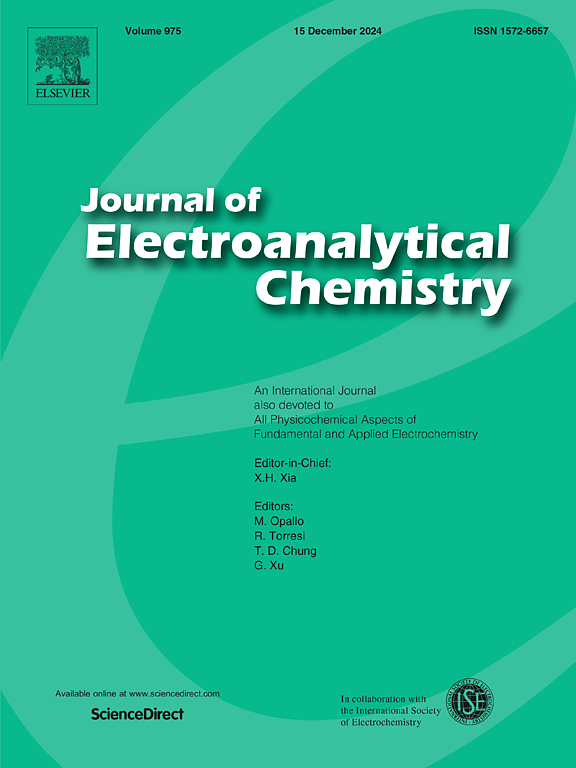Electroanalysis of amphetamine-type stimulants at nitrogen-doped carbon nanotube-modified electrodes
IF 4.1
3区 化学
Q1 CHEMISTRY, ANALYTICAL
引用次数: 0
Abstract
This paper reports the utility of nitrogen-doped carbon nanotubes (N-CNT) and a chitosan biopolymer in the development of simple, cheap and rapid electroanalytical method for the detection of two important amphetamine-type stimulants, 3,4-methylenedioxyamphetamine (MDA), and 3,4-methylenedioxymethamphetamine (MDMA). The method used a screen-printed electrode (SPE) modified with the N-CNT/chitosan matrix, and its analytical performance was investigated by square wave voltammetry (SWV). The designed assay was short (<1 min per sample) and allowed the detection of MDA down to 0.22 μM with a linear range up to 50 μM (R2 = 0.998) in a pH 10.0 phosphate buffer solution. The limit of detection for MDMA was 1.2 μM with a linear range up to 150 μM (R2 = 0.992) in a pH 7.4 phosphate buffer. The spike-and-recovery experiments demonstrated accuracy of the method with good recovery of signal from MDA (93–99 %) and MDMA (82–94 %) in human urine and saliva. The proposed method required simple sensor preparation steps, used microliter-size (50 μL) sample volume and enabled the use of a single electrode for extended period (19 days) while retaining 94–96 % of the initial signal recorded from MDA and MDMA. The use of N-CNT/chitosan matrix for electrode modification offered a rapid method with a sensing platform that can potentially be integrated into portable devices for screening and analysis of the psychoactive stimulants in the biofluids.

安非他明类兴奋剂在氮掺杂碳纳米管修饰电极上的电分析
本文报道了氮掺杂碳纳米管(N-CNT)和壳聚糖生物聚合物在两种重要的苯丙胺类兴奋剂3,4-亚甲基二氧基苯丙胺(MDA)和3,4-亚甲基二氧基苯丙胺(MDMA)的简单、廉价和快速电分析检测中的应用。该方法采用N-CNT/壳聚糖基质修饰的丝网印刷电极(SPE),并采用方波伏安法(SWV)研究其分析性能。设计的检测方法时间短(每个样品1 min),在pH 10.0的磷酸盐缓冲溶液中,MDA的检测范围低至0.22 μM,线性范围高达50 μM (R2 = 0.998)。在pH 7.4的磷酸盐缓冲液中,MDMA的检出限为1.2 μM,线性范围达150 μM (R2 = 0.992)。峰回收率实验表明,该方法对人尿和唾液中MDA(93 - 99%)和MDMA(82 - 94%)的信号具有良好的回收率。该方法的传感器制备步骤简单,样品体积为50 μL,单电极使用时间延长(19天),同时保留了MDA和MDMA记录的94 - 96%的初始信号。使用N-CNT/壳聚糖基质进行电极修饰提供了一种快速的方法和传感平台,可以集成到便携式设备中,用于筛选和分析生物体液中的精神活性兴奋剂。
本文章由计算机程序翻译,如有差异,请以英文原文为准。
求助全文
约1分钟内获得全文
求助全文
来源期刊
CiteScore
7.80
自引率
6.70%
发文量
912
审稿时长
2.4 months
期刊介绍:
The Journal of Electroanalytical Chemistry is the foremost international journal devoted to the interdisciplinary subject of electrochemistry in all its aspects, theoretical as well as applied.
Electrochemistry is a wide ranging area that is in a state of continuous evolution. Rather than compiling a long list of topics covered by the Journal, the editors would like to draw particular attention to the key issues of novelty, topicality and quality. Papers should present new and interesting electrochemical science in a way that is accessible to the reader. The presentation and discussion should be at a level that is consistent with the international status of the Journal. Reports describing the application of well-established techniques to problems that are essentially technical will not be accepted. Similarly, papers that report observations but fail to provide adequate interpretation will be rejected by the Editors. Papers dealing with technical electrochemistry should be submitted to other specialist journals unless the authors can show that their work provides substantially new insights into electrochemical processes.

 求助内容:
求助内容: 应助结果提醒方式:
应助结果提醒方式:


